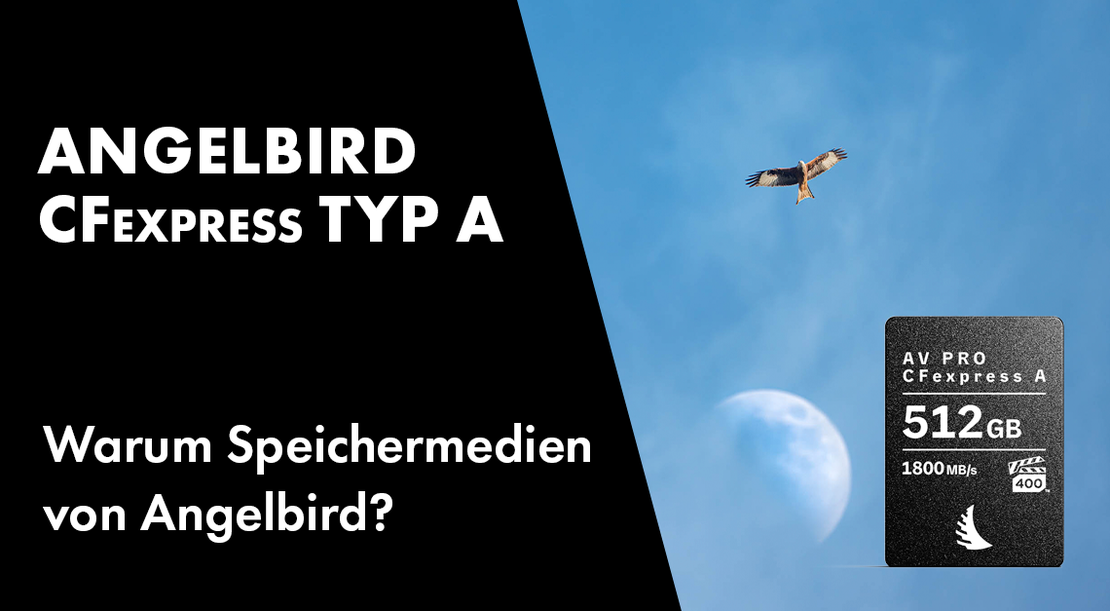
Angelbird CFexpress A - Review
- Marvin Kuhn
- Review , Accessories , Storage media
- April 8, 2025
Table of Contents
Why I use Angelbird memory cards, and why you might want to as well
The world of camera media has fundamentally changed over the decades. Once large metal plates dominated image storage, followed by the era of film, later digital media with floppy disks, and today we primarily work with small, mostly black memory cards. Formats like SD, CFexpress, or XQD may appear barely distinguishable at first glance; even the brands seem to operate similarly. But as minimal as the differences may appear on the surface, the quality and performance values of individual products are crucial in detail.
Safety: Not by chance, but by conscious choice
For me, this applies: When handling my images, I leave nothing to chance. Particularly critical are the storage media used directly in the camera. A defective memory card during a shoot can have devastating consequences, namely the absence of a backup. That’s exactly why I rely on high-quality products that perform reliably throughout the entire workflow. Reliable memory cards not only ensure that data is securely stored but also help workflows run smoothly.
Another crucial point is the speed of the card. A card that’s too slow causes the camera to enter a buffer mode, which costs valuable time when saving, especially critical during burst shooting or video recording. High write speeds and stable performance both in the camera and during later reading on the computer are therefore essential to avoid interrupting the creative process.
My Recommendation: Angelbird
For years, I have been using Angelbird memory cards without any incidents. Initially, it was their SD cards with which I had excellent experiences. Recently, I’ve also expanded my equipment with the newer CFexpress Type A cards, which were specifically developed for Sony cameras. Both formats have impressed me in terms of performance and reliability. If we can infer the longevity of CFexpress cards from the SD cards, the durability is excellent, as all my SD cards are still functional (knock on wood).
Why CFexpress Type A from Angelbird?
Angelbird guarantees a minimum write speed of 800 MB/s for their CFexpress Type A cards, which is far more than Sony cameras actually need or can utilize as of April 2025. The cards could potentially reach over 1800 MB/s for short bursts, which I cannot test with my CFexpress Type 2.0 card reader. Additionally, the cards with their VGP400 certification are among those that support this standard for Type A. This is particularly interesting for anyone recording professional video who needs the guaranteed write rate for their camera to be able to use all possible formats. Another advantage is the available sizes, ranging from 256 GB to 1 TB, which are significantly lower in price per GB than Sony’s offerings, despite higher performance.
The high write rate is not just advantageous in theory. In practice, it’s evident that the buffer of my Sony A1 II, which has space for about 95 RAW images, is cleared in around 15 seconds, corresponding to a realistic write speed of 550 to 600 MB/s. Here, the limitation is predominantly with the camera and not the memory card. When reading via my card reader, I consistently achieve values of at least 750 MB/s with a 16 GB test file. This doesn’t quite match Angelbird’s specifications, which could be due to my more affordable card reader.
Service and Support that Impress
Another plus point for Angelbird is their excellent customer support. The memory cards are developed and produced in Austria, which in practice means that I’ve always received quick and straightforward assistance with problems and questions, whether in German or English. Additionally, Angelbird offers a three-year warranty, which is by no means a given in the highly competitive industry of storage media.
Conclusion
Memory cards may appear inconspicuous at first glance, but they are the heart of every recording. Anyone who wants to know their data is in safe hands should pay particular attention to quality and performance. For me, Angelbird is the first choice because it combines reliability, high write speeds, and excellent service. So if you’re looking for high-quality storage media for your camera, I recommend taking a closer look at Angelbird.
Disclaimer
The opinions expressed here are my own and based on my personal experiences with Angelbird memory cards. I have not received any financial incentives or benefits from Angelbird to write this review. The decision to use Angelbird memory cards is based on my conviction of their quality and performance.
Copyright © of product image in the title image are the ones of the respective manufacturers. All rights reserved.




